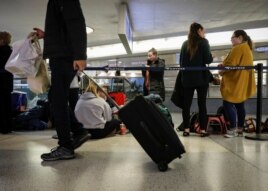22 November 2020
The COVID-19 pandemic is affecting Thanksgiving holiday plans for many American families.
The Associated Press reports that coronavirus cases are rising at a worrying speed across the United States. The Johns Hopkins Coronavirus Resource Center says the virus has killed over 250,000 people nationwide. Many people are getting infected every day.
The U.S. Centers for Disease Control and Prevention (CDC) last week released guidelines on the safest way to celebrate Thanksgiving. The CDC is advising Americans not to travel over the holiday this year. And it is urging them against spending time with people from outside their immediate household.
The warning is some of the firmest guidance yet from the CDC on how to limit the spread of the virus. The health care system is under great pressure in many communities. Sick patients are filling up hospital beds, while some medical workers are getting sick themselves.
Holiday celebrations seem like a perfect way to spread the coronavirus. In some families, people come together from different parts of the country. Holiday gatherings usually include many generations -- from young children to their grandparents.
Older adults may have health problems such as diabetes, obesity, or heart disease. The CDC website says that these conditions raise the risk "of severe illness from the virus that causes COVID-19."
And people may not know they are infected with the coronavirus. Experts note that students returning home from college may carry the virus and not know it. Younger people are more likely to have asymptomatic infections.
Experts have been advising people to limit their contact to a single group of people, called a "bubble." Less contact with people outside the bubble means a lower risk of infection.

Travelers move through the boarding area for trains during the Thanksgiving holiday travel rush at Pennsylvania Station in New York, U.S., November 27, 2019. REUTERS/Brendan McDermid
The act of traveling carries risks
Thanksgiving usually is the busiest travel period of the year in the United States. Some 50 million Americans travel 80 or more kilometers to share a meal with friends and family. This information comes from AAA, an automotive and travel group.
Crowded buses, trains, and waiting rooms with poor ventilation, or airflow, are places where the virus can easily spread. The longer the trip, the higher the risk.
Airplane travel is less clear.
The dangers begin before getting on a plane, train or bus, notes Cameron Wolfe, a professor at the Duke University School of Medicine.
Dangerous celebrations
Gathering family members and friends indoors for long periods of time raises the chances for the virus to spread.
This is happening already, notes Doctor Anthony Fauci, head of the National Institute of Allergy and Infectious Diseases.
"If you look around the country now, many of the infections are in small family-and-friend gatherings such as dinner parties and small social gatherings," he said.
Fauci explained that the danger is when one person who is asymptomatic and infected gets others infected.
The U.S. Centers for Disease Control and Prevention says that about 40 percent of those infected do not have clear symptoms but can still spread the virus.
Getting tested for the coronavirus before traveling might be helpful. However, experts urge caution.
Most rapid tests do not work well for people who are not showing signs of the disease, they note. Even the best tests can miss an early infection. And people can get infected in the time between getting tested and when they arrive for holiday celebrations.
I'm Anna Matteo.
Mike Stobbe and Heather Hollingswort reported this story for the Associated Press. Some information also came from Steve Baragona's report for VOA News. Anna Matteo adapted both for VOA Learning English. George Grow was the editor.
_______________________________________________________
Words in This Story
pandemic – n. a disease affecting many people over a wide area or throughout the world
obesity – n. the medical term for being overweight or very fat
ventilation – n. the movement of fresh air through a room or building
asymptomatic – adj. producing or showing no signs of disease
bubble – n. a thing ball of liquid enclosing air or another gas
household – n. those who live in the same house or home
rapid – adj. marked by a fast rate of motion or activity
caution – n. a warning; telling someone to be careful